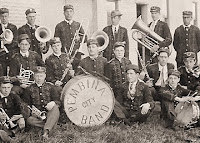 One Dominion Day celebration in Emerson brought out a combined [brass] band from Fort Pembina, Emerson, and Dominion City. Tubby Ardis of Pembina was on the bass drum and during the street parade the band played the Ruby Rose March. Tubby was carrying the drum high, as bass drummers do, and marching along at a fairly good clip when he ran right square into the silent policeman1 (big cast-iron affair weighing well over 200 pounds). The impact forced Tubby to turn a complete backward somersault which landed him right on his feet. Coming down he accidently hit his drum twice, right in time with the music, and never missed a beat. Spectators watching the parade figured the band had engaged a trick drummer especially for the occasion. From DOMINION CITY: Fact, Fiction & Hyperbole
One Dominion Day celebration in Emerson brought out a combined [brass] band from Fort Pembina, Emerson, and Dominion City. Tubby Ardis of Pembina was on the bass drum and during the street parade the band played the Ruby Rose March. Tubby was carrying the drum high, as bass drummers do, and marching along at a fairly good clip when he ran right square into the silent policeman1 (big cast-iron affair weighing well over 200 pounds). The impact forced Tubby to turn a complete backward somersault which landed him right on his feet. Coming down he accidently hit his drum twice, right in time with the music, and never missed a beat. Spectators watching the parade figured the band had engaged a trick drummer especially for the occasion. From DOMINION CITY: Fact, Fiction & Hyperbole 1 - Before the days of the horseless carriage, horse & buggy drivers pretty much drove where they pleased, obeying rudimentary traffic rules. Generally, horses would not run into each other, regardless of what kind of attention was being paid by their driver. There were no one-way streets around the turn of the 20th Century, and if everyone kept to the right, few problems developed.
1 - Before the days of the horseless carriage, horse & buggy drivers pretty much drove where they pleased, obeying rudimentary traffic rules. Generally, horses would not run into each other, regardless of what kind of attention was being paid by their driver. There were no one-way streets around the turn of the 20th Century, and if everyone kept to the right, few problems developed.However, with the advent of the newfangled gasoline-powered automobiles, which came upon the scene during the early 1900's, drivers, both horse and auto, would become much more aware of the problems which arose when they met.
Horse owners complained of the high speeds that autos drove–up to 20 miles per hour!–and the noisy engines, which scared their teams. To accommodate and protect the horse teams, proper etiquette dictated that cars must keep to the right of center, and not exceed a 6 mile per hour speed when turning street corners.
How far right, was right? Some vehicles would cut a corner, thereby getting into the oncoming lane, with potential disastrous results. Intersections were the worst, where four streets met. Few, if any, stop signs existed then, so who had the right-of-way?
Instead of having a traffic officer at each busy intersection directing traffic, the problem was solved with the installation of what was then called a “Silent Policeman”. It consisted of a cement pillar, about 5 feet high, usually with a shiny globe on top. The globe sometimes lit up at night for better visibility. It was understood that, upon entering an intersection, drivers must always keep to the right of the Silent Policeman. If one wished to make a 90 degree left-hand turn, the driver would have to turn right, circle the pillar and exit at the desired street. It was a type of “roundabout” commonly used in Europe at the time.
From Silent Policemen by Bill Schuette
Thanks for the kind words, Bill. You got me intrigued now - I'll have to go check you out LOL
ReplyDelete